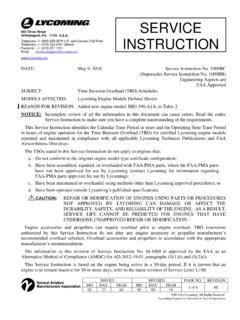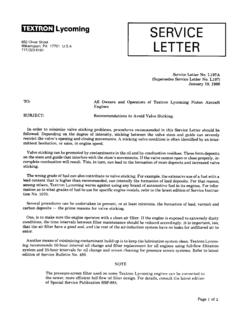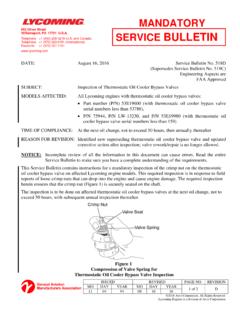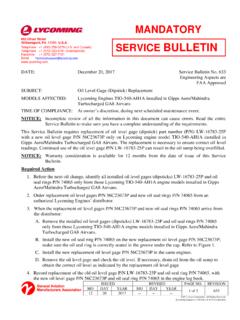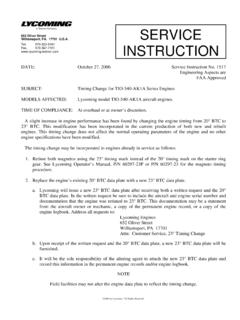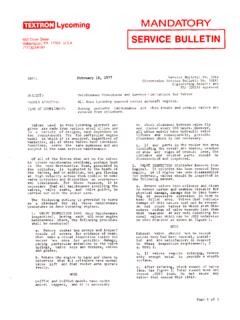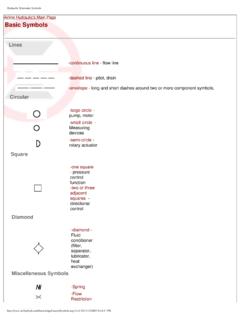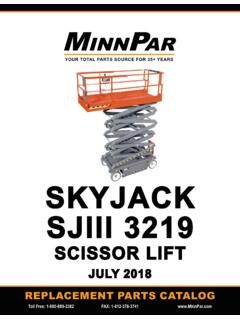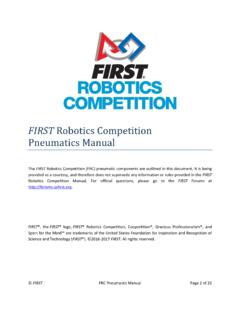Transcription of 652 Oliver Street Williamsport, PA. 17701 U.S.A. - Lycoming
1 652 Oliver Street Williamsport, PA. 17701 SERVICE. INSTRUCTION. Tel. 570 323 6181. Fax. 570 327 7101. DATE: December 29, 2010 Service Instruction No. 1427C. (Supersedes Service Instruction No. 1427B). Engineering Aspects are FAA (DER) Approved SUBJECT: Lycoming Reciprocating Engine Break In and Oil Consumption MODELS AFFECTED: All fixed wing and rotary wing aircraft (horizontal installations only) with Lycoming reciprocating aircraft engines installed TIME OF COMPLIANCE: After field overhaul NOTE. Incomplete review of all the information in this document can cause errors.
2 Read the entire Service Instruction to make sure you have a complete understanding of the requirements. Background This Service Instruction identifies the necessary steps for engine break in, including engine preparation for ground operational tests, flight tests, after flight tests, and oil consumption limits for Lycoming engines installed in fixed wing and rotary aircraft. NOTE. Engine overhaul includes, but is not limited to, replacing applicable components such as: fuel pump, fuel metering unit, and magnetos, if applicable, with components that are overhauled, rebuilt, or new.
3 Ideally, this procedure is to be done in a test cell where operating conditions can be closely monitored. If the engine is operated in a test cell, the engine must have intercylinder baffles, a cooling shroud, and a test club installed for engine Revolution Per Minute (RPM) requirements. If a test cell is not available, use a test stand with a test club and a cooling shroud for the engine test. If a test cell or a test stand is not available, do an engine test after the engine has been installed in the aircraft with the intercylinder baffles installed.
4 If the engine is operated in the aircraft, use a test club or aircraft propeller for correct air flow cooling. The engine to cowling baffles must be new or in good condition for correct cooling air flow differential across the engine. The cylinder head temperature gage, oil temperature gage, oil pressure gage, manifold pressure gage and tachometer must be calibrated for accuracy. The purpose of a test cell or ground run test if done with the engine installed in the aircraft is to make sure that the engine is in compliance with all specifications, RPM, manifold pressure, fuel flow and oil pressure.
5 The oil cooler system must hold oil temperatures within limits shown in the applicable Lycoming Operator's Manual. ISSUED REVISED PAGE NO. REVISION. MO DAY YEAR MO DAY YEAR. 1 of 7 C. 10 21 83 12 29 10. 2011 Avco Corporation. All Rights Reserved. Lycoming Engines is a division of Avco Corporation. The purpose for this engine break in procedure is for correct piston ring seating and stable oil consumption on a top overhauled engine or a newly overhauled engine that is installed in the aircraft. NOTE. The following formula is used to calculate the maximum allowable oil consumption limits for all Lycoming aircraft engines.
6 X BHP x 4 = 1. FIXED WING. A. PREPARATION FOR GROUND OPERATIONAL TEST WITH ENGINE INSTALLED IN. AIRCRAFT. NOTE. Refer to the latest revision of Service Instruction 1014 for the recommended oil to be used for engine break in on Lycoming engine models. In most cases, turbocharged engines are to use ashless dispersant oil for break in. Non turbocharged engines are to use aviation grade mineral oil for break . in. Follow Service Instruction 1014 to use the correct oil for break in. 1. Do the engine pre oil in accordance with the latest revision of Service Instruction No.
7 1241. 2. Calibrate the cylinder head temperature gage, oil temperature gage, oil pressure gage, manifold pressure gage, and tachometer before the ground operational test. CAUTION. MAKE SURE THAT ALL VENT AND BREATHER LINES ARE INSTALLED CORRECTLY. AND ARE SECURELY IN PLACE IN ACCORDANCE WITH THE AIRFRAME. MAINTENANCE MANUAL. 3. Install all airframe baffles and cowling 4. For optimum cooling during the ground operational test, use a test club. If the test club is not available, use the regular flight propeller, however, monitor the cylinder head temperature closely.
8 B. GROUND OPERATIONAL TEST. NOTE. Before the ground operational test, the oil cooler system must not have any air locks. If the engine had failed before overhaul, it is possible that the oil cooler, propeller and governor could have been contaminated. During overhaul, these parts were to either be replaced or cleaned and examined by an approved repair facility. 1. Before the start of the ground operational test, examine the oil cooler, propeller, and governor for metal contamination. These parts must be clean and free of contamination before the ground operational test can begin.
9 2. Put the aircraft in a position facing the wind. 3. Start the engine and look at the oil pressure gage. If sufficient oil pressure indication is not shown within 30 seconds, stop the engine. Identify and correct the cause. ISSUED REVISED PAGE NO. REVISION. MO DAY YEAR MO DAY YEAR 1427. 2 of 7 C. 10 21 83 12 29 10. 4. If oil pressure is sufficient, operate the engine at 1000 RPM until the oil temperature is stable or is at 140 F (60 C). After warm up, the oil pressure is not to be less than the minimum specified pressure in the applicable Lycoming Operator's Manual.
10 5. Increase engine speed to 1500 RPM and operate at that speed for 15 minutes. 6. Make sure the cylinder head temperature, oil temperature and oil pressure is within the specified limits in the Lycoming Operator's Manual. NOTE. Extended ground operation can cause excessively high cylinder and/or oil temperatures. NOTE. If any malfunction occurs, stop the engine and let it cool. Identify and correct the cause before continuation of the ground operational test. a. Start the engine again and monitor oil pressure.
